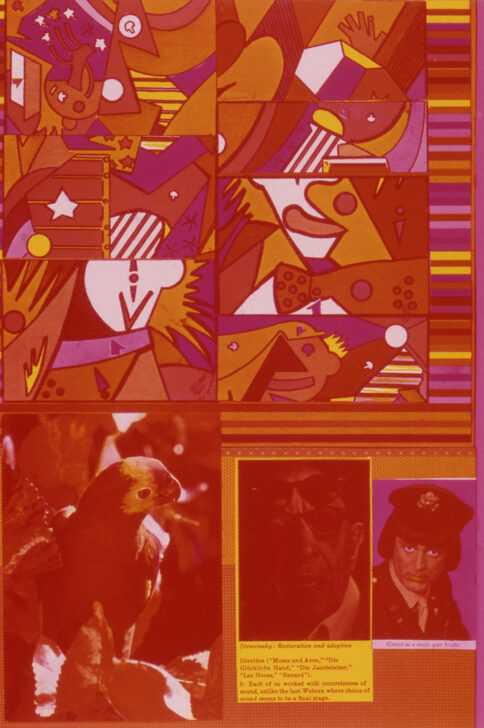Cary Grant as a male war bride
Sir Eduardo Paolozzi ; Richard Davis; Editions Alecto

Description
Subject Matter:
Like many of his contemporaries, Paolozzi used new printing techniques as a way to engage with modern mass media's new visual culture. At the same time, the photomechanical process made the work look mechanically manufactured rather hand made, in the traditional artistic sense. Therefore, after he modified, transformed, and assembled the source image(s), the medium would allow for a more uniform final image.
This print is one of a large series of 50 prints included in the 1970 portfolio, which was a second edition of an earlier group of slightly-larger prints titled "Moonstrips Empire News." While the first series was strictly produced as screenprints, this second series "General Dynamic F.U.N." includes works of photolithography, like this one. The themes seen in this portfolio are different in style and subject matter from other Pop works of the period, but engage with the images of a modern mass media, looking beyond just advertising and publicity images. Likewise, the title of the portfolio alludes to the General Dynamics Corporation, who was the manufacturer of the F-111 fighter used during the Vietnam War—the same one referenced in James Rosenquist monumental painting "F-111."
Like other works in this series, Paolozzi points to the downfall of the American dream. The title for this work references the 1949 film, staring Cary Grant, Ann Sheridan and Marion Marshall, titled "I Was a Male War Bride," and the image on the bottom right is of Grant in costume for the film. In the film, pictured in the image used by Paolozzi, Grant must crossdress in order to qualify under the "War Bride Act" to return to the United States after World War II with his new wife, an Army nurse who has been transfered back State-side. The other portrait, of the important Russian composer Igor Stravinsky, is a photograph contemporary to the creation of the print series—the composer died the year after its publication in 1971. The visual comparison between the two is humorous, the old bald man with two pairs of glasses and the middle-aged man dressed in drag. There is perhaps here a play on the comically-outmoded early-twentieth century male stars, and the modernist culture that they represented. The text below Stravinsky's photo gives a hint: it references librettos by his contemporaries and disparages the work of another contemporary Anton Webern, who was admired by the avant-garde composer John Cage. At the same time, his inclusion might be a reference to the theft of European culture by American, in reference to the 1940 controversy over Stravinsky's The Rite of Spring and it's use of Walt Disney's 1940 Fantasia. Though the inclusion of the bird connotes sound/music, the bird looks over to the two men suspiciously. The pseudo-cubist or constructivist scenes above look like cut outs from childrens books or comics, making the whole scene seem even more ridiculous and possibly referencing the Disney controversy.
Physical Description:
This photolithographic print in pink, red, orange and yellow is made of four main parts. A series of patterns from stripes at the top to small to tiny polka dots at the bottom make up the background. The stripes are in all the colors of the print, where the dots are only in orange and red. At the top left, there are a series of fragments of geometric scenes. In the bottom left, in orange, red and yellow, there is a bird, likely a parakeet. Then to the right at the bottom, there are two photographs of white men. On the right, there is a photograph of an older man with one pair of prescription glasses on and a pair of sunglasses resting on his forehead with the text below that reads: "Stravinsky: Restoration and adaptation / librettos ('Moses und Aron,' 'Die Glückliche Hand,' 'Die Jacobsleiter,' 'Les Noces,' 'Renard'). / 9. Each of us worked with concreteness of sound, unlike the last Webern where choice of sound seems to be a final stage." On the left, there is a man in three-quarter view with sholder-length hair and a military uniform, and the text below reads "Grant as a male war bride."
Usage Rights:
If you are interested in using an image for a publication, please visit https://umma.umich.edu/request-image/ for more information and to fill out the online Image Rights and Reproductions Request Form.